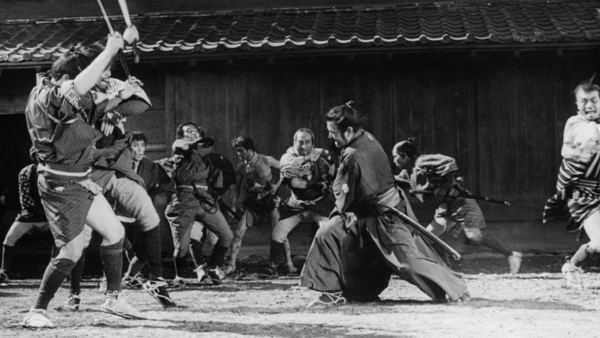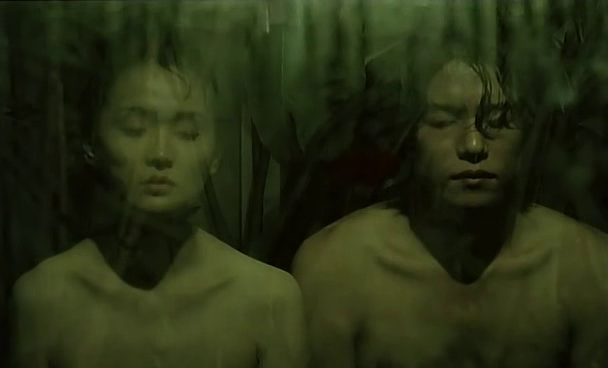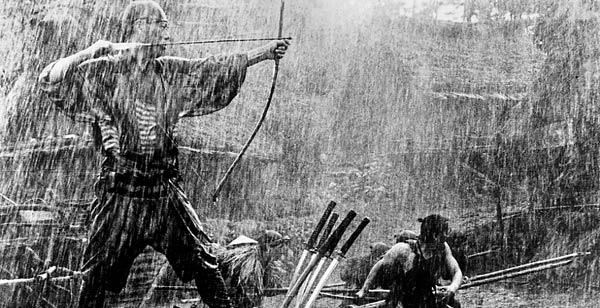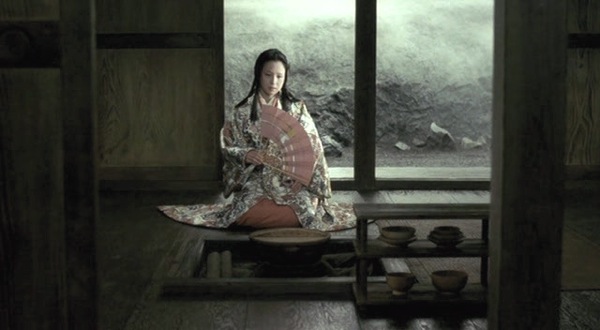 Sukiyaki, Chow Mein, Minestrone
Sukiyaki, Chow Mein, Minestrone
Asia Minor & Other Eastern Modes Part 2
published in The Wire No.162, August, 1997, LondonFor the West, the terrain of 'world music' is mapped by the otherness of alien cultures and their difference to Eurocentric harmony and rhythm. This is smelly musicology at best: African, Asian , Pacific & Latin musics are defined by their own identity and history, and not by their blunt contrast to Western convention. Subsequently, part of their identity is shaped by their distorted mirroring of the same Western conventions to which they appear so different. The beauty of 'world music' - despite the attempts of musicological purists - is that it is as dilutable, distillable, combustible and compoundable as the most impure pop music we produce. Postwar Japan - a gleaming, highly designed, decidedly 'un-ethnic' environment - is the most fertile ground where these impurities take root and blossom, nurturing a peculiar Easterness lined with contradiction.
What is this Easterness I'm talking about? What does it sound like? What is its flavour? Taste Humio Nayasaka's score for Akira Kurosawa's THE SEVEN SAMURAI (1954). It commences with a long fade-up of authentic Japanese military drumming (the key rhythm for the whole score), then is halted by a bizarre male vocal chorus harmonizing a brief motif straight from a 19th Century New England barber shop quartet. Then the real weirdness begins: a melody in a traditional folk modal is played against some overly-relaxed 20s-style razzamatazz brass harmonies. The mind can't even begin to conjure a collaged image to match the music. This isn't a disembodied Arabian vocal line slapped onto a mid-70s funk break-beat: this is total molecular fusion at the score's aural centre.
Yet while a cultural whirlpool draws the Western ear into a spiral of misinterpretations, the function of Nayasaka's score is deceptively straightforward: he has composed a theme that embodies the numerous conflicting traits of the seven personalities upon which the film's action, drama and pathos rides. The score - as musical character script - connotes headiness, rashness, sobriety, reserve, cunning, mawkishness, triumph, fear. All at once. Western film composers - inheriting the grandiose and heroic traditions chiselled into the marble busts of 18th/19th century romantic composers - structure their scores to synchronize minute musical tinctures to every emotional drop wrung from the screen. This mania for synchronization belies the predictable delusion that by timing music to action and mimicking emotional states, one somehow controls that action like a grand wizard. Ultimately, this approach is literal, linear, laboured. THE SEVEN SAMURAI's composition is radically opposed: it is lateral, liquid, loose. The score's contrary themes have been deliberately writ according to a densely webbed logic of asynchronism: music never coincides, motifs never coalesce, moments never congeal.
If Godzilla's gorgeously gross footsteps are imprints of the Japanese soundtrack's carefully crafted explosiveness, the polymorphous tonality of THE SEVEN SAMURAI evidences the Japanese film score's wavering harmonic colour. It serves as our musicological earpiece to over a century of musical mutations - particularly in the first half of this century when popular Japanese music was excited by the inflections and intonations of European and American jazz. The point is that Japanese music was not simply 'modernized' this century: it has been genetically altered. It is simultaneously a traditional past, an eclectic present and an imagined future, and it thrives on this ahistorical blend of shifting possibilities.
One of the themes in THE SEVEN SAMURAI is played by - of all things - a tenor sax. That would be as formally anachronistic as having a twanging electric guitar in an American western. But not an Italian western. Cineastes can cite that THE SEVEN SAMURAI was remade in Hollywood as THE MAGNIFICENT SEVEN (1960) and that Sergio Leone remade Kurosawa's YOJIMBO (1961) into A FISTFUL OF DOLLARS (1963) - yet they ignore that Ennio Morricone imported the musical sukiyaki of THE SEVEN SAMURAI and YOJIMBO to Leone's spaghetti westerns. Masaru Satoh's score for YOJIMBO is influential in many respects. YOJIMBO ('thief') is one of many Kurosawa films based on the character Toshio Mifune played in THE SEVEN SAMURAI, through which he defined a rebel/loner spirit who exhibited a strangely Eastern existentialism while engaged in acts of extreme violence. Satoh's main theme casts him as a wry, laconic, playful, gruff, perverse, likeable rogue, roaming through an absurdly vicious landscape. Again, the music conveys all these traits simultaneously through the mix of incongruous elements in the arrangement: electric guitar, bongoes and harpsichord jostle against brooding Gothic intonations (which owe a strained debt to Stravinsky's distinctive orchestral colouration). Just as Marco Polo imported noodles from the Chinese to make Italian pasta, Morricone fused this postwar Japanese eclecticism with an equally unique Italian tradition of excessive ornamentation. Listen and you will taste it.
The 60s in Japan is a radical time wherein its post-nuclear condition (and its postmodern effects) are made manifest. Parallel to its industrial rise, electronics revolution and urban rebirthing (peaking for the 1966 Tokyo Olympics), Japan's entertainment and recording industries go into overdrive, accelerating their importation of styles and devices. If global centres like Paris and New York have been symbolized by dumb architectural edifices like the Eiffel Tower & the Empire State Building, Tokyo is symbolized by Tokyo Tower: a broadcast/receiver. The Japanese were - and still are - sucking in the infosphere of the West and extruding it into unimaginable forms, constructs and mechanisms. This is the very characteristic of data dispersion which influenced Stockhausen's TELEMUSIK (1966), composed as an impression of Tokyo's overload of broadcast communications. At that time, Japan was the socio-industrial construct of what futurists and experimentalists had been poetically imagining for over fifty years. Not suprisingly, the Japanese soundtrack - recording the collapse of sound, noise and music into each other - captures and renders the aural dissolve between all levels of sonic and musical signification.
Horoyuki Nagashima's score for Sogo Ishi's ANGEL DUST (1995) is Stockhausen's TELEMUSIK revisited. The film is sublime on many levels, but its sound design and film score (each impossible to separate from the other) constitute a delicate yet assaultive collage of musical fragments which hurtle, jettison and freeze mid-air throughout the film like a series of alien objects. I say ' objects' because the score to ANGEL DUST seems an arrangement of pre-composed pieces which are then savagely excerpted, cross-faded and inserted as glimpses on one's aural periphery. No cues, no passages, no sections. Only an onslaught of textures which signify the presence of musicality without actually advancing any music. It is almost as if Nagashima is doing a live broadcast of the film soundtrack by wildly flicking through the tuner dials of a bank of short wave radios. Music comes and goes, leaving one more conscious of its presence than its content, more massaged by the extremities of its frequency range than by its formal orchestration.
In its frenetic editing and mixing, ANGEL DUST simultaneously evokes the work of Haruomi Hosono, Ken Ishi, DJ Shadow, K. K. Knull, Solmania & Ryoji Ikeda - all of whom have in their own way revived and reclaimed Stockhausen's highly materialist concept of the electronic globe (a sono-musical appreciation of information technologies as opposed to the 90s appropriation of McLuhan's immaterial ideas of global media convergence). In short, the Japanese actively sound these ideas: they sculpt noise, paint tones and cast timbres in reflection of the post-nuclear environment within which their recording industry is situated, giving us a rush of shivers, spasms and stabs in the name of music. ANGEL DUST may superficially sound planets away from THE SEVEN SAMURAI, but the technique of deftly combining diverse elements into a heterogenous musical landscape is as evident in both films as it is absent in the Western film score tradition.
Sogo Ishi's most recent film - THE LABYRINTH OF DREAMS (1997) - proves that this Eastern sensibility is operating beyond both classical and romantic precepts of musical convention. The score by Hiroyuki Onagawa may aesthetically sound like beautiful ambient stylings (certainly it is lushly textured without drooping into New Age upholstery) yet the rubric of dispersion, aura and diffusion governs the placement and progression of the score's many incidental moments. It's flow and momentum cojoins ANGEL DUST at a deeper level, where harmonious discord and tempered dissonance reflect the Japanese philosophical acceptance of the how beauty and ugliness are at one with the other.
This meld of the beautiful and the ugly breathes through every audio-visual fibre that cross-threads Kiju Yoshida's ONIMARU (Demon Child, 1988) - a spare Eastern-Gothic film loosely based on Jane Austen's WUTHERING HEIGHTS. The cinematography consistently frames its characters with contemplative pictorial nuance, alienating their being in the spaces which trap them. Outdoors, the film's minuscule figures carve elegant lines of movement across the barren spread of the Sacred Mountain (an unforgivingly barren moonscape of volcanic grey). Indoors, the same figures are frozen in hermetic relief against the austere minimalism of the mountain's feudal mansions. The score by Toru Takemitsu enhances the many splits between interior psychological states and exterior action, between repressed silence and uncontrolled utterance, between the vast ugly noise of the mountain and the strained beautiful ambience of the mansion. Simply, whenever we are inside, we hear tuned wind drafts and tunnelled air vents; outside, we hear no natural sound effects, but only the murmur of music and the rumble of ill-defined orchestration. Characteristically reverent of music's accord to film narrative, Takemitsu actively de-composes this score as the situation warrants it, excusing himself of the bolshy heroism that so governs the domain of the film composer. With rooms that hum, wind that sings, walls that exhale and clothes that sigh, ONIMARU is perhaps the most potent musical example of how the Japanese soundtrack is the sound of the west turned inside out.
Text © Philip Brophy 1997. Images © respective copyright holders




